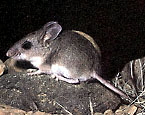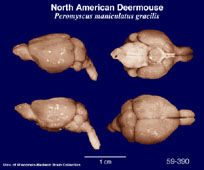|
North American Deermouse
(Peromyscus maniculatus gracilis) #59-390 |
||||
|
|
Physical
characteristics and distribution
|
|
Peromyscus maniculatus gracilis has a longer tail, ears, skull, and hind foot than P. m. bairdii. It is grayish to reddish brown with white underparts. The fur is short, soft, and dense. The finely-haired tail is bicolored, the darker top half and the lighter bottom sharply differentiated. It is typically 119 to 222 mm long and weighs between 10 and 24 grams. Tail length is variable in different populations and ranges from 45 mm to 105 mm. It eats a wide variety of plant and animal matter depending on what is available, including insects and other invertebrates, seeds, fruits, flowers, nuts, and other plant products. They consume seeds of valued forest trees, sometimes preventing regrowth. In addition, P. m. gracilis can be destructive by raiding stored grains and other food supplies. They help disperse the seeds of a number of species of plants, and also the spores of mycorrhizal fungi. In addition, they are a food source for a wide variety of animals at higher trophic levels. Males use their home ranges for both access to feeding and nesting and also to reproductive females. Females use their home ranges for feeding, nesting, and rearing young. Reproductive females are more aggressive in territory defense than males, and their territories overlap less, suggesting that they have a greater investment in territory defense than males. Females are seasonally polyestrous with an estrous cycle of about five days. In the wild, reproduction may not occur during winter or other unfavorable seasons. Females exhibit post-partum estrus and are able to become pregnant shortly after giving birth. The gestation period of a nonlactating female deer mouse lasts from 22.4 to 25.5 days and 24.1 to 30.6 days in a lactating female. Litter size is highly variable between populations. Peromyscus maniculatus may have litters containing from one to eleven young with typical litters containing four, five, or six individuals. Litter size increases with each birth until the fifth or sixth litter and decreases thereafter. P. m. gracilis is very altricial at birth but develops quickly. At birth, the deer mouse has a mass of about 1.5 g. The young are born hairless with wrinkled, pink skin, closed eyes, and folded over ear pinnae. Juvenile hair begins to develop on the second day after birth. On the third day, the pinnae unfold with the ear canal opening on the tenth day. Eyes open on the fifteenth day, and the young are weaned between day 25 and 35. Conception can occur as early as 35 days, but the first estrus typically occurs around 49 days. Peromyscus maniculatus gracilis are found in forested areas in the Panhandle of Alaska and across N Canada, south through most of continental USA, excluding the SE and E seaboard, to southernmost Baja California and to Sur NC Oaxaca, Mexico; including many landbridge islands (see details: Mammal Species of the World, Vol 2, 2005, p1071-2).
|
|
Description
of the brain
|
|
Animal
source and preparation
|
|
All
specimens collected followed the same preparation
and histological procedure.
|
Other Related Resources (websites and publications)
List of Specimens | Explore Collections | Brain Sections | Brain Evolution | Brain Development | Brain Circuitry | Brain Functions | Location and Use | Related Web Sites | Contact Us | Search MSU Database | Personnel | Home



